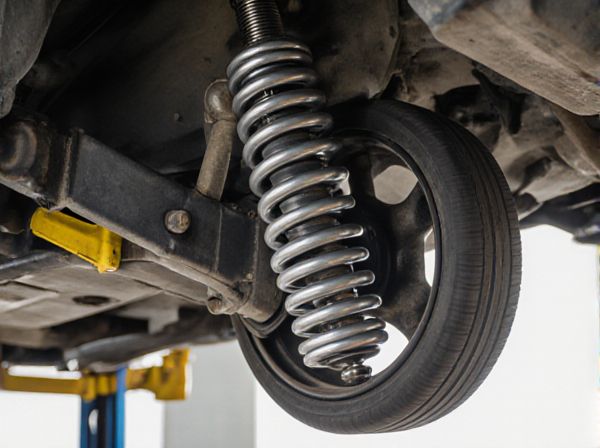
Photo illustration: Leaf Spring vs Coil Spring
Leaf springs provide robust support and load-bearing capabilities, making them ideal for heavy-duty vehicles and trucks. Coil springs offer smoother ride quality and better handling, commonly used in passenger cars and light vehicles. Your choice depends on the desired balance between durability and comfort.
Table of Comparison
| Feature | Leaf Spring | Coil Spring |
|---|---|---|
| Design | Stacked metal plates | Helical metal coil |
| Load Capacity | High load support, common in trucks | Moderate load, used in cars and SUVs |
| Ride Comfort | Stiffer, less comfortable | Smoother, absorbs shocks better |
| Durability | Robust and long-lasting | Durable but prone to sagging |
| Complexity | Simple design, easy to maintain | More complex, requires precise mounting |
| Cost | Economical and cost-effective | Typically more expensive |
| Weight | Heavier, adds unsprung mass | Lighter, improves handling |
| Applications | Trucks, vans, heavy-duty vehicles | Passenger cars, sport vehicles, SUVs |
Introduction to Leaf Springs and Coil Springs
Leaf springs, composed of multiple layers of flexible steel strips stacked and bolted together, provide robust support and load-bearing capacity in heavy-duty vehicles and trucks. Coil springs, made from tightly wound steel wire, offer improved ride comfort and flexibility, commonly used in passenger cars and light trucks. Both suspension types absorb shocks and vibrations but differ significantly in design, application, and load distribution efficiency.
Historical Development of Suspension Systems
Leaf springs, dating back to ancient Roman chariots, represent one of the earliest suspension technologies designed to absorb shocks and maintain vehicle stability through stacked metal strips. Coil springs emerged in the 19th century, revolutionizing suspension by offering enhanced flexibility and smoother ride quality through helical-shaped steel coils. This transition from leaf to coil springs marks a pivotal shift in automotive engineering, optimizing vehicle dynamics and passenger comfort.
Key Differences Between Leaf Springs and Coil Springs
Leaf springs consist of multiple layers of metal strips stacked and curved to absorb shocks, commonly used in heavy-duty vehicles for load-bearing capacity. Coil springs are helical-shaped metal coils providing greater flexibility and smoother ride quality, often found in passenger cars and light trucks. Key differences include load distribution, with leaf springs offering uniform support over a larger area, while coil springs deliver enhanced suspension articulation and improved handling dynamics.
Advantages of Leaf Spring Suspension
Leaf spring suspension offers superior load-carrying capacity and durability, making it ideal for heavy-duty trucks and commercial vehicles. Its simple design reduces maintenance costs and ensures consistent performance under heavy loads. The ability to evenly distribute weight across the axle enhances stability and ride quality on rugged terrain.
Advantages of Coil Spring Suspension
Coil spring suspension offers superior ride comfort and handling due to its ability to absorb road irregularities more efficiently than leaf springs, resulting in smoother vehicle dynamics. This type of suspension provides better weight distribution and flexibility, enhancing vehicle stability and reducing wear on other suspension components. Furthermore, coil springs are lighter and more compact, contributing to improved fuel efficiency and allowing for more innovative suspension designs in modern vehicles.
Performance Comparison: Leaf Spring vs Coil Spring
Leaf springs provide robust load-bearing capacity and durability, making them ideal for heavy-duty vehicles and off-road applications. Coil springs offer superior ride comfort and precise handling due to their ability to flex more independently, commonly used in passenger cars and sports vehicles. Performance-wise, leaf springs excel in weight distribution and stability under heavy loads, while coil springs enhance suspension responsiveness and overall driving dynamics.
Ride Comfort and Handling: Which Is Better?
Coil springs offer superior ride comfort compared to leaf springs due to their ability to absorb road irregularities more effectively, resulting in smoother and more controlled vehicle dynamics. Leaf springs, while providing robust load-bearing capacity and durability, tend to produce a stiffer ride that can compromise comfort, making them ideal for heavy-duty trucks and off-road vehicles. For enhanced handling, coil springs deliver better responsiveness and stability, particularly in passenger cars, as their design allows for precise wheel control and reduced unsprung weight.
Durability and Maintenance Considerations
Leaf springs offer superior durability in heavy-duty applications due to their robust, multi-leaf design, making them ideal for trucks and commercial vehicles. Coil springs provide a smoother ride but generally require more frequent inspection and replacement in off-road or high-stress conditions. Maintenance for leaf springs often involves regular checks for cracks and corrosion, whereas coil springs need attention to potential sagging and coil breakage over time.
Applications: When to Choose Leaf vs Coil Springs
Leaf springs are ideal for heavy-duty applications such as trucks, trailers, and commercial vehicles where load-bearing capacity and durability are critical. Coil springs are preferred in passenger cars, SUVs, and light trucks for improved ride comfort, better handling, and enhanced suspension flexibility. Choosing between leaf and coil springs depends on factors like vehicle weight, load requirements, and desired ride quality.
Conclusion: Selecting the Right Suspension System
Choosing between leaf spring and coil spring suspension depends on vehicle type and intended use; leaf springs offer superior load-bearing and durability for heavy-duty trucks, while coil springs provide enhanced ride comfort and better handling in passenger cars. Factors such as payload capacity, ride quality, maintenance requirements, and off-road performance must be considered to optimize suspension efficiency. Selecting the appropriate suspension system improves vehicle stability, safety, and overall driving experience.
 caratoz.com
caratoz.com